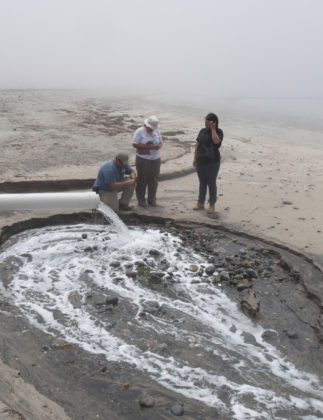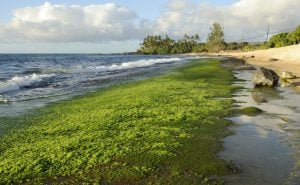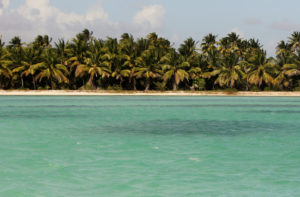About 97% of the world’s water is saline and just 1% is fresh. As this fresh water comes under increasing pressure from climate change and population growth, more countries are building desalination plants to make salt water drinkable, and to supply industry and agriculture.
A recent paper by researchers at three universities, including the UN University Institute for Water, Environment and Health (UNU-INWEH), paints a worrying picture of the environmental impact of the chemical-laden brine that results from this process.
For every litre of fresh water output, the researchers say, desalination plants produce on average 1.5 litres of brine. Though the exact amount varies according to the salinity of the feed water, the desalination method and local conditions, the researchers estimate that globally, plants now discharge 142 million cubic metres of brine a day – a 50% increase on previous assessments.
Since almost 80% of brine from desalination is produced within 10km of the coast, it is typically discharged directly into oceans or emitted into surface water, sewers, or wells, according to the paper.
The brine poses major risks to ocean life and marine ecosystems by greatly raising the salinity of the seawater it flows into, and by polluting oceans with toxic chemicals used as anti-scalants and anti-foulants, including copper and chlorine.
“Brine underflows deplete dissolved oxygen in the receiving waters,” says lead author Edward Jones, from Wageningen University in the Netherlands. “High salinity and reduced dissolved oxygen levels can have profound impacts on benthic organisms (such as worms, clams, crabs, lobsters and sponges that live in the seabed), which can translate into ecological effects throughout the food chain.”
Brine needs to be better managed to deal with a dramatic rise in the number of desalination plants worldwide, the researchers said. Starting from a few, mostly Middle Eastern facilities in the 1960s, today nearly 16,000 desalination plants are operational in 177 countries.
Sector trends
However, Jonathan Bishop, desalination specialist at engineering consultancy Mott MacDonald, says that the UN paper conflated two desalination methods and misread the industry’s direction of travel.
There are essentially two different types of desalination technology, he explains. Under the more traditional thermal processes, salty water is repeatedly boiled and condensed. Thermal treatment is very successful in removing salt, and does not suffer too many operational issues.
However, it uses a lot of power, and around 75% of the water imported into the system is discharged as warm, slightly saltier water. The thermal technique has mostly been used in the Middle East, where energy has historically been cheap, and has typically been co-developed with power stations, Bishop notes.
The second method, established in the 1990s, is reverse osmosis. This removes salt from water by applying mechanical pressure through a semi-permeable membrane. This has rapidly improved in efficiency, and now uses around a quarter of the power of the thermal desalination process. Moreover the brine it produces is not heated, though it is around 50% saltier than feed water, he says.
“I certainly see the brine disposal from the more modern reverse osmosis plants as a much more manageable solution. We’ve looked at currents and modelling of these outfalls, and you can easily demonstrate that the impact of the plume of seawater around them very quickly drops off to the same as the sea. Whereas, a large amount of warm brine going into the sea from a thermal plant can have quite a significant impact, as with warm water from power stations,” he says.
Thermal desalination processes produce four times as much brine per cubic metre of fresh water as those using reverse osmosis.

Bishop points out that no countries outside the Middle East are building new thermal desalination plants. Even this region is turning away from thermal technology, with Oman and the United Arab Emirates both stating they will not build any more.
Dr Peter Harrop, chair of consultancy IDTechEX, does not believe that brine damaging wildlife is a particularly serious problem at the moment. “But it’s a legitimate concern for the future and there should be tighter regulations to prevent irresponsible output of salt water in one area.”
Though brine does not mix very quickly with seawater, he suggests that innovative solutions could be found, such as building desalination plants alongside wave or tidal power plants that would churn the water up and disperse the brine.
Alternative uses
The UN researchers did point out that the environmental problem of excess brine could instead present economic opportunities in fish farming and agriculture.
“Reject brine has been used for aquaculture, with increases in fish biomass of 300% achieved. It has also been successfully used to cultivate the dietary supplement spirulina, and to irrigate forage shrubs and crops (although this latter use can cause progressive land salinisation),” adds Dr Manzoor Qadir, assistant director of UNU-INWEH.
Such uses are being researched at the International Center for Biosaline Agriculture in Dubai. Dr Dionysia Aggeliki Lyra, an agronomist specialising in salt-tolerant species at the centre, explains that certain types of fish such as tilapia and sea bream thrive in the brine. The waste they produce enriches the water, which can in turn be used to irrigate salt-tolerant plant species, such as sea beet and salicornia bigelovii – a multi-purpose halophyte (saline-tolerant plant) that can be used as a vegetable, in animal feed and for biofuel production.
Schemes that combine aquaculture and agriculture can increase food, improve nutrition and secure livelihoods, she says.
However, Lyra adds that the quality of the brine produced depends on the desalination technology and the quality of feed water. “The reject brine should be checked for heavy metals and other chemicals before use in growing fish and crops for human consumption and animal feed,” she says.
Salt and metals contained in brine, which include magnesium, gypsum, sodium chloride, calcium, potassium, chlorine, bromine and lithium, could also be extracted for commercial uses, the UN paper suggests. Recovering these resources is very expensive now but technological improvements could change that. Countries producing large volumes of brine could benefit, according to Qadir.
Harrop is optimistic that it will become economically viable to separate brine into its component minerals as solar power falls in cost. “Technology is moving at breakneck speed and very cheap electricity can provide viability for getting those salts out,” he says.
Bishop points out that power-use has a far bigger environmental impact than brine discharges. Both problems could be drastically reduced if society was more efficient in its use of water. Primary consumption needs to be reduced. Water can be reused where practical, such as for industry, and recycled through advanced wastewater treatment processes that produce both drinking and non-drinking water. Treating recycled water to the highest standard is still less energy-intensive than desalination, he adds.
“The point is often made that perhaps there’s a beneficial use for the waste water, but my view is that we should concentrate on driving down energy consumption in the first place, and try and take advantage of secondary uses and encourage more efficient potable water use,” he says.








![A view of receding flood waters in Srinagar city during the September 2014 flooding. [image: Athar Parvaiz]](https://dialogue.earth/content/uploads/2017/11/A-view-of-receding-flood-waters-in-Srinagar-city-during-the-September-2014-flooding-Credit-Athar-Parvaiz-e1509633052651-300x225.jpg)
